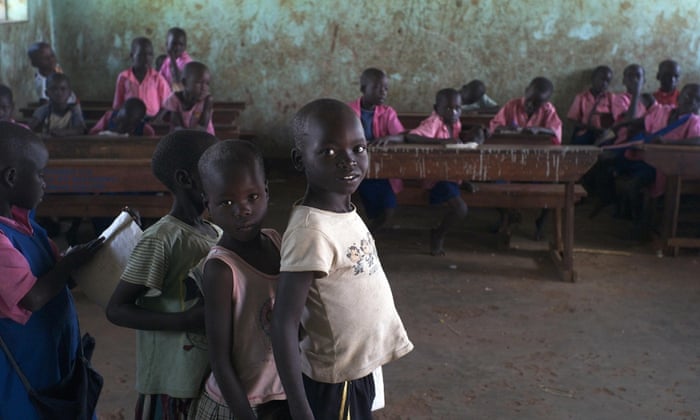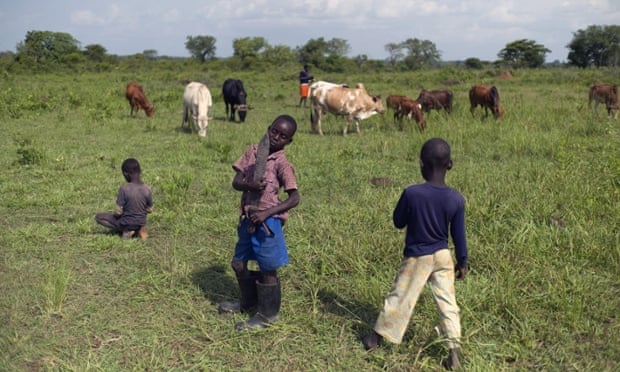A gentle drizzle beats an insistent rhythm on the rusty, corrugated iron classroom roof at Katwe primary school in a suburb of Kampala, Uganda’s capital.
It is a chilly morning and children in the primary one class are learning the alphabet. “A, B, C,” they repeat after their teacher. But many of these children will not finish their seven years of primary education.
Irene Namusuubo Guloba, the headteacher, says: “Around 250 of our pupils did not come back this year. We cannot tell exactly where they went.” This exodus of pupils is not unusual here – some transfer to other schools, but others drop out completely, Guloba says.
Katwe primary is one of the government schools implementing the Universal Primary Education (UPE) scheme.
When the initiative started in 1997, as part of a national policy to provide free primary education for underprivileged children, it was a dream come true for most poor parents in the east African state. Wealthier parents take their children to private schools.
In record time, numbers in UPE schools soared. Enrolment increased from 3.1 million pupils in 1996 to 8.4 million in 2013.
The numbers are evenly spread between boys and girls. And the country has been commended for achieving more than 90% of MDG2, which aimed to ensure that all children – boys and girls alike – complete primary school.
But this success seems to be falling apart amid a very high number of dropouts and poor-quality schooling for some of those who complete primary school.
The UN Educational, Scientific and Cultural Organisation (Unesco) has estimated that 68% of children in Uganda who enrol in primary school are likely to drop out before finishing the prescribed seven years.
Chad has the highest dropout rate in sub-Saharan Africa, at 72%. In east Africa, Kenya has the highest completion rateof 84%.
At a cabinet ministers’ retreat last month, Uganda’s President Yoweri Museveni expressed his rage over the rate at which pupils were leaving school, even when the country spent 900bn Ugandan shillings ($302m; $201m) annually on the scheme. He said: “We should get an answer, and if you think it [UPE] needs to be restructured, we do that.”
The scheme faces a myriad of issues: gender challenges, child labour, early marriages, less motivated teachers, and lack of awareness among parents. However, the biggest challenge is poverty.
Dr Nicholas Itaaga, a UPE expert and a lecturer at Makerere University’s School of Education, says poorer parents still struggle to meet requirements for school. “UPE was a good development for any government to implement. Our problem in Uganda [is that] it was not adequately planned. We are losing out.”
The major setback for UPE is that it is not entirely free, contrary to the general perception that parents are not supposed to pay for anything.
For poorer parents, especially in rural Uganda, the cost of pens, exercise books and clothing is beyond their reach
In practice they still have to buy scholastic materials including pens, exercise books, clothing and even bricks for classroom construction. They also have to provide or buy lunch for their children. For poorer parents, especially in rural Uganda, who live on about $1 a day, the cost is beyond reach.
Charles Mugerwa is the father of an 11-year-old boy in Kasenyi village, Kalangala district, in central Uganda. On a school day, his son is at home. Asked why, Mugerwa said: “He has no uniform.”
The poorer regions – northern and eastern Uganda – experience higher dropout rates. Western and central regions are regarded as better off.
Government figures indicate poverty levels have declined in Uganda, from 24.5% in 2009-10 to 19.7% in 20012-13.
“Do not expect a pupil who comes to school and there is no hope for a lunch[time] meal to stay in school,” Guloba says.
Some schools now ask parents to pay between $2 and $5 a pupil for every three-month term so that they can prepare lunch for them. But some parents still cannot afford to pay, and their children end up dropping out.
“I have been to the deep rural areas and a simple thing such as an exercise book or sanitary pads for the girls is a very big issue,” Itaaga says.
An estimated 30% of girls leave school when they start their periods, often because of a lack of sanitary pads.
At Katwe, the school steps in for parents and buys pads for the pupils. “I actually have big girls here. The school provides some money to buy sanitary pads. The senior woman talks to them and they are comfortable,” Guloba says. “We are able to keep them in class”.
But not all girls have that chance so they end up dropping out, deterred by inadequate facilities, particularly the lack of privacy when boys and girls share latrines.
Fagil Mandy, former chairman of Uganda’s National Examinations Board, feels that the critical role schools can play is insufficiently acknowledged and evaluated. “The school as an institution has not been focused on by any major authority. It is a life-nurturing place, and should be overseen and monitored all the time,” Mandy says.
Government statistics show that for every 71 pupils there is one latrine. NGOs and bodies including the World Bank have funded the construction of classrooms and toilets for some schools, but much more help is needed to provide adequate facilities for the huge numbers of pupils involved.
The education minister, Jessica Alupo, says the high dropout rate is a great concern for the government: “We want to know why all parents send a child to school when they are in primary one and the numbers decrease as they ascend to upper classes. We want to engage them [parents] much more than before.”
Margaret Rwabushaija, chair of Uganda’s National Teachers’ Union, says the government must increase funding to schools. Since 1997, she says, it has not revised the amount of money it pays to educate a child annually, which stands at 7,560 shillings. “How do you expect headteachers to run schools without money?” she asks.
Another major issue has been quality of teaching. A 2012 study found that three out of 10 pupils in primary three could read and comprehend a primary two-level story. At primary seven, the final class in the primary cycle, two out of 10 pupils could not read a primary two-level story. This has created a huge knowledge gap between children of the “haves”, studying in private schools, and the “have-nots”, in government schools.
Betty Bitainensha, deputy head teacher at government-aided Kitante primary school in Kampala, says public schools often have the best-trained teachers, but they are less motivated to work. Teachers are among the lowest paid public servants in Uganda. The government has pledged to increase teachers’ salaries in the 2015-16 financial year.
Alupo says she is optimistic about the future, but only if they can focus on the key obstacles: “Are teachers at school at all times? Are they are motivated to teach? Is the environment conducive for the learners? And finally is there a special programme to talk to parents about their role and obligation?”

